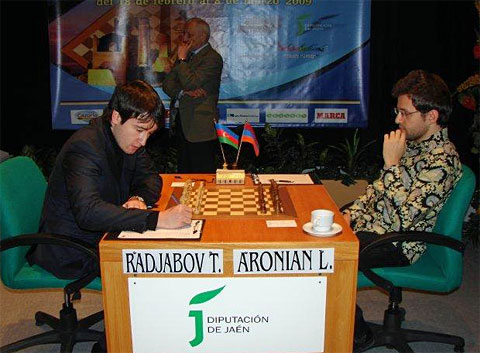
XXVI Linares 2009
This year the Linares 2009 tournament is being staged only in Spain –
in the previous three years the first half was in Morelia, Mexico, and next
year the first half will probably be in the Arab Emirates. The 2009 event goes
from February 19th to March 7th, with three rest days. The prize fund is 314,000
Euros, with the winner getting 100,000 Euros, followed by 75,000 and 50,000
Euros for second and third place. There are no appearance fees for the players,
so the motivation to fight for points may be unusually high. The venue is el
Teatro Cervantes de Linares, the starting time of the games is 16:00h (4 p.m.)
Spanish/European time.
Round ten report
Round 10: Monday, 2 March 2009 |
Teimour Radjabov |
1-0 |
Levon Aronian |
Vishy Anand |
½-½ |
Leinier Domínguez |
Magnus Carlsen |
0-1 |
Wang Yue |
Alexander Grischuk |
½-½ |
Vassily Ivanchuk |
|

The landmark statue of a Linares miner in the center of the city

The start of a fairly tough game that ended in a draw in 35 moves
Commentary by GM Mihail Marin

Radjabov,T (2761) - Aronian,L (2750) [A07]
XXVI SuperGM Linares ESP (10), 02.03.2009 [Mihail Marin]
1.Nf3 d5 2.g3 Bg4 3.Bg2 e6 4.0-0 Nd7 5.d4
For more than a century, players of all levels have been fascinated by the
magic of the white king's fianchetto in the closed openings. The analytical
distilling process, aimed to reveal the optimal move order ressembles the search
for the Golden Wool from the Middle Age. In the genuine Catalan Opening, White
frequently has problems satbilising the position because of the possible d5xc4
at different stages of the game. If White refrains from an early c2-c4, this
means defining the bishop's intentions too soon, allowing Black choose the rock
solid Slav setup, which is supposed to offer White no advantage at al, because
his bishop would bite in stonel. I have passed through this whole process over
the past 17 years and I know that there is no universal answer to the problem.
It all depends on such subjective factors as the speciffic opponent or the mood
in which you are that day. Judging from the course of the present game, Radjabov
found the right move order, against the right opponent at the right moment.
5...c6 6.Nbd2 Ngf6 7.Re1. It is interesting to compare the first moves
with the following sequence with reversed colours: 1.d4 Nf6 2.Nf3 g6 3.Bg5 Bg7
4.c3 d5 5.Nbd2 Nbd7 6.e3 0-0 7.b4 c6 8.Be2 Re8 followed by ...e5. This is how
the game Torre-Kasparov, Thesaloniki (ol) 1988 started. About ten moves later,
the reigning World Champion had a big advantage already. There is an interesting
psychologycal nuance involved in reversing colours. What is entirely satisfactory
with black does not look equally appealing with white. This is a possible reason
why Radjabov's plan from this game is not seen frequently at grandmaster level.
7...Be7 8.e4 dxe4 9.Nxe4 0-0 10.c3 Re8 11.Nxf6+
11...Bxf6?! This is the start of Black's troubles. Aronian takes the
e5-square under control in order to carry out the freeing pawn break e6-e5 as
soon as possible, but leaves the d5-square insufficiently well protected. 11...Nxf6
would have been more natural and probbaly better. Black would play ...Nd5, ...Qb6
and ...Rad8, waiting for a favourable moment to open the centre with c6-c5.
12.h3 Bh5 13.Qb3 Qb6
14.Nd2! A strong move, threatening Nc4, with the aim of provoking the
exchange Qxb3, axb3, followed by b3-b4 which would ensure White some queenside
advantage. 14...e5 With the d5-square poorly defended, Black is not well-prepared
for this move, but passive play would not have ensured easy life either. 15.d5
Qc7 16.d6 Qb8 17.Ne4 Bd8 18.Be3 Bb6 19.h4 h6 20.Bh3 Qd8
The opening has been a major success for White. It is not really usual in super-tournaments
that White gets such an advantage on move 20 already. 21.Bxh6! White
wins a pawn with a simple combination. 21...Nc5!? This looks like the
best practical chance. Black rids himself of the passive knight and eliminates
the disturbing d6-pawn. 21...gxh6 22.Bxd7 Qxd7? loses the queen to 23.Nf6+.
22.Nxc5 Qxd6 23.Nd7 Qxh6 24.Nxb6 axb6 25.Qxb6 Bf3 26.Qe3 Qh5 27.Bg2 Bxg2
28.Kxg2 Ra4 29.Qg5 Qxg5 30.hxg5
White's advantage does not consist from the extra-pawn only, which, in many
rook endings, is not sufficient for a win, see for instance the game Ivanchuk-Wang.
He has space advantage on the kingside, while the e5-pawn and the seventh rank
are vulnerable. 30...Kh7. 30...Rg4 leaves the rook trapped after 31.f4!
31.a3 Kg6 32.Rad1 Re6 33.Rd7 b5 34.Red1 Rc4 35.Rc7 e4 36.Rdd7. After
the occupation of the seventh rank, White should win without problems. 36...e3.
A desperate counterplay. 37.fxe3 Rxe3 38.Rxf7 Rg4 39.Rxg7+ Kh5 40.Rh7+
Kg6 41.Rcg7+ Kf5 42.Rf7+ Kg6 43.Rhg7+ Kh5 44.Rf3 Re2+ 45.Kh3 Rxg5 46.g4+ Kh6
47.Rxg5 Kxg5 48.b3 Kg6 49.Kg3 Ra2 50.Kf4 Rxa3 51.b4
The position has calmed down and Black has managed to prevent the material
defficit from increasing. However, his pieces are not coordinated, which allows
White win effortlessly. 51...Kf7. 51...Ra1 is no better because of 52.Rd3
threatening Rd6+. 52.Ke5+ Ke7 53.Rh3 Kd7 54.g5 Ra1 55.Rh7+ Ke8 56.Rc7 1-0.
[Click to replay]
Commentary by GM-elect Anish Giri

Anish Giri, who debuts as an annotator on our news pages, is currently the
youngest grandmaster
in the world. He made his final (third) GM norm in January at the tender
age of 14 years, seven months and two days. He is of Russian-Nepalese extraction
– born in St Petersburg of a Russian mother and a Nepalese father, with
the family now living in Holland. Anish speaks four languages: Russian (his
"mother tongue"), English, Japanese (he lived there with his family
for some years), and a smattering of Nepalese. He is learning Dutch.
Originally Anish had undertaken to comment on Linares games this weekend, but
he ended up stuck in a hotel without a proper Internet connection while playing
in the German Bundesliga. Incidentally he has made a fourth GM norm in this
team championship. Currently FIDE still lists him as a FIDE Master. So when
he officially receives his title he will be one of the very rare players (perhaps
the only one) who went straight from FM to GM! [We have been told by our
ever-watchful readers that Kramnik made the jump from FM to GM during the 1992
Manila Olympiad.]
The Bundesliga games this weekend were interesting: on Saturday Anish had world-class
GM Etienne Bacrot on the ropes, but went on to lose the game. When we asked
him what had happened he answered with impish humour: "I was winning after
the opening, just winning. And I even saw the winning line. But then I found
another way to win which was even better, except that it lost. These 2700 players,
they are so lucky!" In the second game he defeated German GM Falko Bindrich,
rated 2508. You can replay these two interesting games here.
Now Anish is back home and vigorously commenting on the Linares games on the
Playchess server. For our news page he
has chosen to analyse the following game. Enjoy!

Carlsen,M (2776) - Wang Yue (2739) [D10]
XXVI SuperGM Linares ESP (10), 02.03.2009
1.d4 d5 2.c4 c6 3.Nc3 Nf6 4.e3 a6 5.Nf3 b5 6.b3 Bg4 7.Bd2. Rare move,
which was played by Morozevich against Ivanchuk in Corus this year. White wants
to play h3-g4 chasing the bishop or exchanging it after h3 Bxf3. 7...Nbd7.
Considering the speed Wang Yue made this move we can conclude that he was
ready for this rare line. 7...e6 is more usual. 8.h3 Bh5 (8...Bxf3
9.Qxf3 with the bishop pair, though Black is very solid and not without
plusses. 9.g4 Bg6 10.Ne5 with some initiative. 8.h3 Bxf3 9.Qxf3 b4 10.Na4
10...e5! Idea of the whole previous play of Wang. He strikes in the
centre and wants to use his lead in development and the white knight on the
edge of the board, which is a bad piece according to a certain Dr.Tarrash (with
whom I fully agree!). 11.Rc1 Bd6 12.cxd5 cxd5 13.dxe5 Nxe5 14.Qd1 0-0 15.Be2.
The last five moves were very logical, but now Wang played 15...a5. A
strong and not very obvious move (for me at least). Black protects the b4 and
a6 pawns for the future. 16.Rc2. An interesting plan by Magnus. He wants
to improve his bishop before castling. 16...Qe7 17.Bc1 Rad8 18.Bb2 Ng6 19.0-0.
Finally when all the white pieces are more less well developed (I am not
talking about Tarrasch's knight!) White castles. 19...Ne4 20.Bd4
20...Nh4! Black has an isolated pawn, but now he shows that he is also
not without play. 21.Bd3. 21.Bb6 a computer-like move. White just wants
to take everything, but Black has his own play agains White's king. 21...Qg5
22.Bg4 (22.g4 Rc8 23.Rxc8 and now there are a lot of ways equalize for black,
but I will just give the nicest. 23...Nf3+!? 24.Kg2 (24.Bxf3 Qe5 with
mate, even though Black is a rook and piece down!) 24...Nh4+ nice perpetual.)
22...h5! 23.Bxd8 Rxd8 24.f4 Qe7 25.Bxh5 Ng3 26.Re1 Nxh5 27.Qxh5 Bxf4 28.Qe2
Bg5 With compensation for the exchange. I would prefer to play with black here,
though the position is far from clear. Those knights on h4 and a4 are not of
the same value! 21...Nf5 22.Bb6 Rb8. By this point White is already not
fighting for the advantage. 23.Bxe4. It is not very good to give your
"good" bishop, but it was a very understandable decision, as the knight
on e4 was really scary. 23.Qe2!? Black's threats look scary, but White
can defend. And after all an isolated pawn is still there. On the other hand
Black has some initiative. I would say the position is equal, but I like Black
more, as some players, like me for example, prefer the initiative. Anyway, it
is just a matter of taste. 23...Qe5 24.g3 Rfc8 25.Rxc8+ Rxc8 26.Rd1 g6 27.Qf3
h5 Something like this could happen after 23.Qe2!? Black's initiative at least
fully compensates for his weaknesses. 23...Qxe4 24.Rd2. 24.Qe2 was safer.
24...Nh4 25.f3 Qg6 26.Rd2 Rfe8 The position is approximately equal, but still
Black keeps some sort of pressure, which compensates for weeknesses on d5 and
a5. Only Black can be better here.
24...Rxb6! The bishop must be killed! Reason: he protected the e3 square.
Poor guy...
25.Nxb6 Qe5. 25...Nxe3!? Would not be so great as it looks
probably. 26.fxe3 Qxe3+ 27.Rdf2 Qxb6 winning attempt.
(27...Qg3 28.Re2 Qh2+
29.Kf2 Qg3+ draw.
) 28.Kh1 Qe3 29.Qf3 Qe5 30.g3 and I think white has
no problems at all.
26.Re1? This was the first and the last mistake, though White probably
made some inaccurate moves earlier.
26.g3! holds the position. 26...Nxg3
27.Re1 Ne4 Trying to play for a win.
(27...Ne2+!? 28.Kf1! Black has nothing
but a draw here.
28...Qh5 29.Kg2 Qg6+ 30.Kf1 Qh5=) 28.f4 Qe6 29.Rg2 Bc5
30.Na4 Ba7 31.Qg4 g6 32.Qxe6 fxe6 with something like equality in this strange
sharp ending.
26...Qh2+ 27.Kf1 Qh1+ 28.Ke2 Qxg2 29.Rxd5 Ng3+ 30.Kd3 Bc7! Wang
Yue is precise!
31.fxg3 Bxb6 32.Kc4. Even such a brilliant move cannot
help White. His king will be in trouble everywhere.
32...Rb8! A very strong
and nice move – the b5 square is taken away from White's king!
33.Kb5 Everything
will lose here, but this move is a blunder. It is understandible – Magnus was
in time trouble and his position was very difficult.
33...Bd4+?! Here Wang missed an opportunity to mate Magnus immediately.
33...Bd8+! just mates. 34.Ka6 other moves do not help either. 34...Bc7
35.Qd4 Qxh3 The Queen is coming back to c8 and mate is inevitable. 34.Kc4
Bf6 35.Qd3 Qxg3 36.Rd1 Qc7+ 37.Rc5 Qb7
38.Qd6? Magnus had less than a minute and not surprisingly he did not
find a best chance, which was given to him by Wang on move 33... 38.Qd7!
To threaten Rc8 with mate at some point later on. 38...Qe4+ 39.Rd4 Qc2+ 40.Kd5
Qg2+ 41.e4 g6 mate on c8 was threatened. 42.Rc8+ Rxc8 43.Qxc8+ Kg7 44.Rd3 and
it is still better for Black, but not that much anymore. 38...Qe4+ 39.Rd4
Qc2+ 40.Kd5 Qg2+ 41.e4 Rd8 42.Qxd8+ Bxd8 43.Rc8
43...g6. The ending is easy for Black, and Wang finishes the game off
nicely. 44.Rxd8+ Kg7 45.Rd3 Qc2 46.Kd4 a4 47.bxa4 Qxa2 48.Kc5 b3 49.Rb8 b2
50.Rdb3 Qxa4 51.Rxb2 Qxe4 52.R8b3 Kh6 53.Rc3 f5 54.Rbb3 Qe5+ 55.Kc4 Kh5 56.Kd3
Kh4 57.Kd2 f4 58.Rf3 g5 59.Rfd3 Qc5 60.Rbc3 Qf2+ 61.Kd1 Qf1+ 62.Kd2 Qg2+ 63.Kd1
Qe4 64.Kd2 h5
0-1. [Click to
replay]
Current standings

Video reports by Europe Echecs
Video reports and interviews are now being provided by Vijay Kumar for
Europe Echecs
Schedule and results
Round 1: Thursday, 19 February 2009 |
Vishy Anand |
1-0 |
Teimour Radjabov |
Levon Aronian |
½-½ |
Magnus Carlsen |
Leinier Domínguez |
½-½ |
Alexander Grischuk |
Wang Yue |
½-½ |
Vassily Ivanchuk |
|
|
Round 2: Friday, 20 February 2009 |
Teimour Radjavov |
½.½ |
Vassily Ivanchuk |
Alexander Grischuk |
1-0 |
Wang Yue |
Magnus Carlsen |
½.½ |
Leinier Domínguez |
Vishy Anand |
0-1 |
Levon Aronian |
|
|
Round 3: Saturday, 21 February 2009 |
Levon Aronian |
½-½ |
Teimour Radjabov |
Leinier Domínguez |
½-½ |
Vishy Anand |
Wang Yue |
½-½ |
Magnus Carlsen |
Vassily Ivanchuk |
½-½ |
Alexander Grischuk |
|
|
Round 4: Sunday, 22 February 2009 |
Teimour Radjabov |
0-1 |
Alexander Grischuk |
Magnus Carlsen |
½-½ |
Vassily Ivanchuk |
Vishy Anand |
1-0 |
Wang Yue |
Levon Aronian |
1-0 |
Leinier Domínguez |
|
|
Round 5: Tuesday, 24 February 2009 |
Leinier Domínguez |
½-½ |
Teimour Radjabov |
Wang Yue |
½-½ |
Levon Aronian |
Vassily Ivanchuk |
½-½ |
Vishy Anand |
Alexander Grischuk |
½-½ |
Magnus Carlsen |
|
|
Round 6: Wednesday, 25 February 2009 |
Wang Yue |
½-½ |
Teimour Radjabov |
Vassily Ivanchuk |
½-½ |
Leinier Domínguez |
Alexander Grischuk |
1-0 |
Levon Aronian |
Magnus Carlsen |
1-0 |
Vishy Anand |
|
|
Round 7:Thursday , 26 February 2009 |
Teimour Radjabov |
½-½ |
Magnus Carlsen |
Vishy Anand |
½-½ |
Alexander Grischuk |
Levon Aronian |
0-1 |
Vassily Ivanchuk |
Leinier Domínguez |
½-½ |
Wang Yue |
|
|
Round 8: Saturday, 28 February 2009 |
Teimour Radjabov |
½-½ |
Vishy Anand |
Magnus Carlsen |
0-1 |
Levon Aronian |
Alexander Grischuk |
½-½ |
Leinier Domínguez |
Vassily Ivanchuk |
½-½ |
Wang Yue |
|
|
Round 9: Sunday, 1 March 2009 |
Vassily Ivanchuk |
½-½ |
Teimour Radjabov |
Wang Yue |
½-½ |
Alexander Grischuk |
Leinier Domínguez |
0-1 |
Magnus Carlsen |
Levon Aronian |
½-½ |
Vishy Anand |
|
|
Round 10: Monday, 2 March 2009 |
Teimour Radjabov |
1-0 |
Levon Aronian |
Vishy Anand |
½-½ |
Leinier Domínguez |
Magnus Carlsen |
0-1 |
Wang Yue |
Alexander Grischuk |
½-½ |
Vassily Ivanchuk |
|
|
Round 11: Tuesday, 3 March 2009 |
Alexander Grischuk |
|
Teimour Radjabov |
Vassily Ivanchuk |
|
Magnus Carlsen |
Wang Yue |
|
Vishy Anand |
Leinier Domínguez |
|
Levon Aronian |
Games - Report |
|
Round 12: Thursday, 5 March 2009 |
Teimour Radjabov |
|
Leinier Domínguez |
Levon Aronian |
|
Wang Yue |
Vishy Anand |
|
Vassily Ivanchuk |
Magnus Carlsen |
|
Alexander Grischuk |
Games - Report |
|
Round 13: Friday, 6 March 2009 |
Magnus Carlsen |
|
Teimour Radjabov |
Alexander Grischuk |
|
Vishy Anand |
Vassily Ivanchuk |
|
Levon Aronian |
Wang Yue |
|
Leinier Domínguez |
Games - Report |
|
Round 14: Saturday, 7 March 2009 |
Teimour Radjabov |
|
Wang Yue |
Leinier Domínguez |
|
Ivanchuk Vassily |
Levon Aronian |
|
Grischuk Alexander |
Vishy Anand |
|
Carlsen Magnus |
Games - Report |
|
Links
The games are being broadcast live on the official web site as well as
on the chess server Playchess.com.
If you are not a member you can download the free
PGN reader ChessBase Light, which gives you immediate access. You
can also use the program to read, replay and analyse the PGN games. |
|
Copyright ChessBase
























































